Beautify Your Home with Timeless Plastering Styles – From Smooth to Textured, Discover the Perfect Finish for Every Space
Are you tired of plain walls in your home? Plastering styles for interiors can add charm and depth to any room. Decorative plaster has been used for centuries to create stunning wall finishes.
This guide will show you different plaster types and how to use them. Ready to transform your space?
Key Takeaways
- Plaster finishes come in many types like smooth, textured, sand, pebbledash, scraped, roughcast, and Venetian.
- Modern plaster options include clay, slaked lime, gypsum, tadelakt, and neo-plaster.
- Plaster adds character, enhances lighting, lasts long, and offers eco-friendly choices for homes.
- Professional plastering costs $10 to $25 per square foot for labor and materials.
- Venetian plaster looks like marble, reflects light, resists mold, and works well in any room.
Understanding Plaster and Its Uses in Interior Design
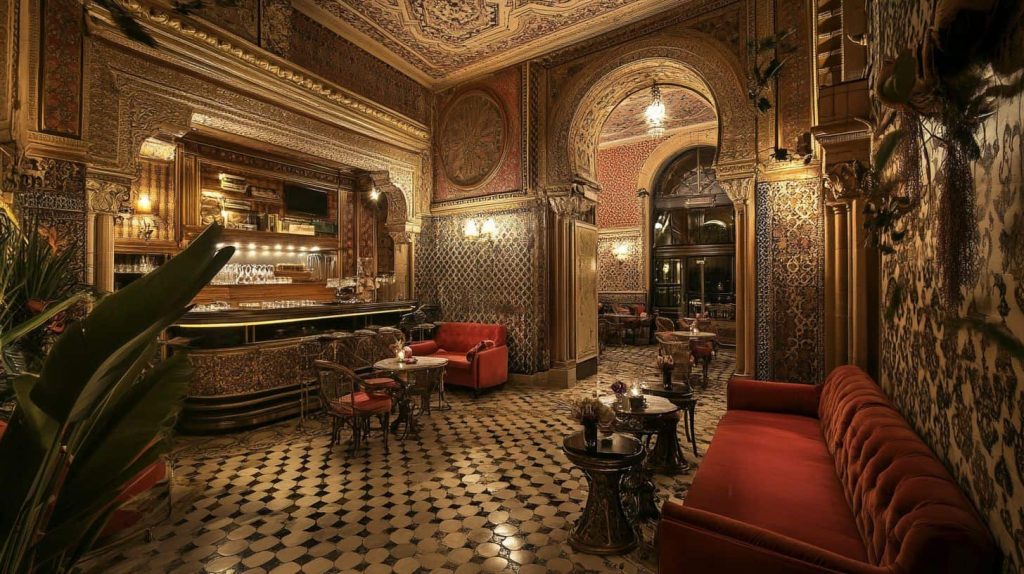
Plaster is a key part of interior design. It’s a mix of water, sand, and lime or gypsum. This mix can create smooth or rough surfaces on walls and ceilings. Designers love plaster for its many uses.
It can make plain walls look fancy or add depth to a room. Plaster also helps with sound and heat in a space.
Plaster comes in many types for different needs. Some are best for wet areas like bathrooms. Others work well in living rooms or bedrooms. The finish can be glossy, matte, or textured.
This gives homeowners lots of choices for their style. Plaster can even mimic other materials like stone or wood. It’s a great way to change a room’s look without spending too much.
Types of Decorative Plaster Finishes

Plaster finishes come in many styles. Each type offers a unique look and feel for your walls.
Smooth
Smooth plaster gives walls a sleek, modern look. It’s a popular choice for homes that want a clean, crisp style. This finish hides small flaws in walls and ceilings. But it needs careful work to get right.
Experts apply smooth plaster in many thin layers. Each layer must dry before the next goes on. Then, they sand it down to create a flat surface. The result? A wall that feels silky to touch.
It reflects light well, making rooms seem brighter and bigger.
Textured
Textured plaster adds depth and character to walls. It comes in many styles, from subtle swirls to bold patterns. This finish hides small flaws in walls and ceilings. Homeowners love how it makes rooms feel cozy and unique.
Textured plaster transforms plain walls into works of art.
You can pick from lots of textures. Some look like sand, while others mimic stone or wood. The plaster can be smooth or rough. It’s great for hiding bumps or cracks in old walls. But keep in mind, that textured walls collect more dust than flat ones.
Sand
Sand plaster adds a unique touch to walls. It mixes fine sand with plaster to create a grainy surface. This finish hides small flaws in walls and gives rooms a cozy feel. Many homeowners like sand plaster for its natural look and texture.
Sand plaster works well in dry areas of a home. It’s not the best choice for bathrooms or kitchens due to moisture. The rough surface can limit paint options later on. But for living rooms or bedrooms, sand plaster offers a warm, earthy vibe that many find appealing.
Pebbledash
Pebbledash adds a unique look to walls. It uses small stones or pebbles stuck to wet plaster. This style hides flaws in walls and makes them tough. Builders often use it outside, but some folks like it inside too.
People who want a bold look might pick pebbledash. It’s hard to paint over, so you must love its natural look. The stones come in different colors and sizes. This lets you make your own special design.
Scraped
Scraped plaster adds depth to walls. Craftsmen use tools to make patterns on wet plaster. This method hides small flaws in the surface. You can pick from many designs – swirls, lines, or waves.
Each look is one-of-a-kind.
Getting the right texture takes skill. The plaster must be just wet enough to scrape. If it’s too dry, it won’t work. Too wet, and the pattern won’t hold. But done right, scraped plaster brings charm to any room.
Roughcast
Roughcast plaster gives walls a rugged look. It uses small stones or pebbles mixed into the plaster. This creates a tough, textured finish that stands out. Homeowners often pick roughcast for outdoor walls.
But it works well inside too, adding a unique touch to rooms.
Roughcast offers both style and strength. It holds up well against wear and tear. The rough surface hides small cracks or flaws. But it can be hard to clean or paint later. Think about your long-term plans before choosing roughcast for your home.
Venetian
Venetian plaster adds a touch of old-world charm to any room. This classic finish uses many thin layers of plaster to create a smooth, polished look. It often mimics marble or stone.
The process stems from ancient Italian methods. Skilled artisans apply the plaster by hand with special tools.
Homeowners love Venetian plaster for its rich texture and depth. It works well in living rooms, dining areas, and entryways. But it’s not ideal for bathrooms or kitchens. These spaces have too much moisture for this delicate finish.
For a similar look in wet areas, try other waterproof options instead.
Exploring Modern Plaster Types

Modern plaster types offer new ways to decorate walls and ceilings. Clay, lime, gypsum, and other plasters give homes unique looks and textures.
Clay Plaster
Clay plaster is a great choice for homes. It’s made from natural clay, sand, and fibers. This mix creates a strong and eco-friendly wall coating. Clay plaster helps control humidity in rooms.
It soaks up extra moisture when the air is damp. Then, it releases that moisture when the air gets dry. This keeps your home comfy all year round.
People with chemical sensitivities often prefer clay plaster. It’s free from harsh chemicals and VOCs. But keep in mind, clay plaster isn’t good for wet areas like bathrooms. You’ll need to mix it on-site before use.
This can take about 35 to 40 minutes. Despite these small drawbacks, clay plaster adds warmth and character to any space.
Slaked Lime Plaster
Slaked lime plaster brings old-world charm to modern homes. It’s made from lime putty mixed with sand and water. This mix creates a smooth, durable finish that gets better with age.
Homeowners love it for its natural look and feel. It also helps control moisture in rooms.
This plaster type breathes well and resists mold growth. It’s great for both new builds and old house restorations. Slaked lime plaster can be tinted with natural pigments for custom colors.
It works well on walls, ceilings, and even in bathrooms. Many find its soft, matte finish adds warmth to any space.
Gypsum Plaster
Gypsum plaster is a top choice for interior walls. It’s easy to use and dries fast. This plaster gives walls a smooth finish that looks great. You can paint it any color you want. It’s also fire-resistant, which makes homes safer.
Homeowners love gypsum plaster for its versatility. It works well in both old and new houses. The plaster helps control noise and keeps rooms at a nice temperature. It’s also not too pricey, making it a smart pick for many home projects.
Tadelakt
Tadelakt is a modern plaster type that can make your home look amazing. It’s a special finish that works in many rooms. You can use it to create smooth or textured walls. This plaster adds a touch of luxury, like Venetian plaster does.
Many homeowners love how it makes their spaces feel elegant and fancy.
You can put Tadelakt in different parts of your house. It looks great in bathrooms, kitchens, and living rooms. The plaster comes in many colors and styles. You can pick one that fits your taste.
Tadelakt is tough and lasts a long time. It also helps keep your home comfy by controlling moisture. This makes it a smart choice for any room in your house.
Neo Plaster
Neo plaster brings a fresh twist to classic plastering. It mixes old methods with new tech for a sleek, modern look. This plaster type uses special resins and polymers. These add-ins make it stronger and more flexible than regular plaster.
Homeowners love neo plaster for its smooth finish and rich color options. It works well in any room, from living areas to bathrooms. Unlike some plasters, neo plaster resist cracks and moisture damage.
It’s also easy to clean and maintain, making it a smart choice for busy families.
Designing with Plaster: Tips from the Indiana Wall Systems
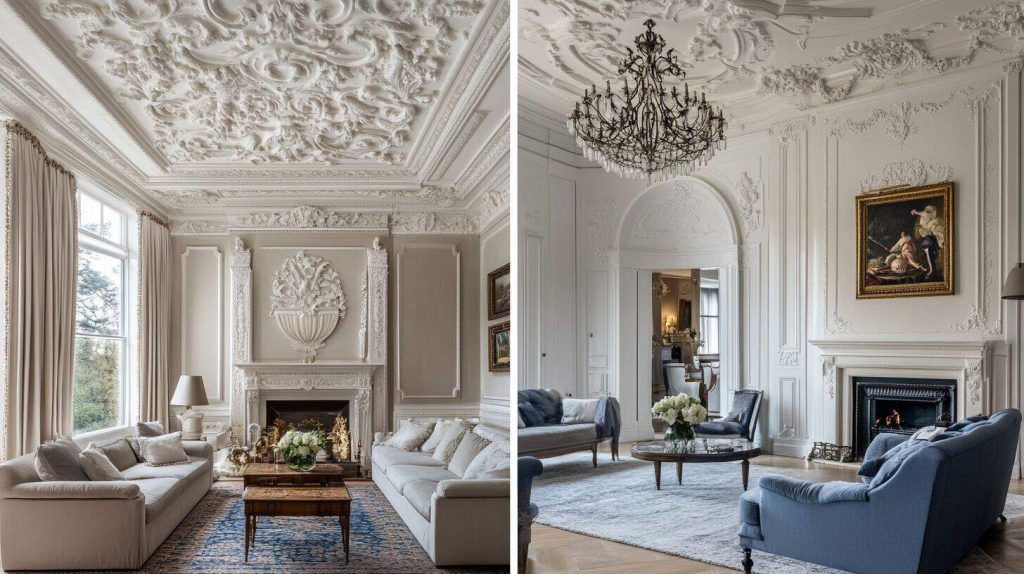
Plaster can transform any space. Experts share tips on using it for walls, fireplaces, and more.
Walls
Plaster walls add charm to any room. They offer a smooth or textured finish that paint can’t match. You can choose from many styles – smooth, sand, or even Venetian. Each type gives a unique look and feel to your space.
Clay plaster is a great choice for walls. It’s eco-friendly and helps control moisture. Simon Astridge used it in his home and loved the calming effect. Gypsum plaster is another option.
It’s cheaper and easy to work with. No matter what you pick, plaster walls will make your home stand out.
Fireplaces
Plaster adds charm to fireplaces. It can make a plain hearth look fancy. You can use smooth or textured finishes. Some folks like a rustic look with rough plaster. Others prefer a sleek style with polished plaster.
The right finish can turn your fireplace into a focal point. It draws the eye and makes the room cozier.
Experts suggest using heat-resistant plaster for fireplaces. This type won’t crack from the heat. You can also add color to the plaster for a unique look. Clay plaster is a good choice.
It’s eco-friendly and helps control moisture in the room. With plaster, your fireplace can be both pretty and practical.
Range Hoods
Range hoods add style to your kitchen while keeping it clean. These handy units pull smoke, steam, and smells out of the air. You can pick from many looks – sleek stainless steel, rustic copper, or custom-painted to match your decor.
Some hoods have built-in lights to brighten your cooking area. Others come with fans that adjust to different speeds.
Plaster finishes can make range hoods truly special. A smooth plaster coat gives a modern, minimalist vibe. Textured plaster adds depth and interest. You could even try Venetian plaster for a luxe, marble-like effect.
The right plaster finish turns a basic hood into a striking focal point in your kitchen.
Wet Areas
Plaster can work well in wet areas like bathrooms and kitchens. But you need to pick the right type. Some plasters hold up better to moisture than others. Clay plaster isn’t a good choice for wet spots.
Instead, go for lime or gypsum plaster in bathrooms and kitchens. These handle dampness better. You’ll also want to seal the plaster to keep water out. This helps stop mold and damage over time.
For the best results, talk to a pro about plaster options for wet areas. They can guide you to products that look great and last long. With the right plaster, you can have stylish walls that stand up to splashes and steam.
Just be sure to care for them properly to keep them looking good.
Powder Rooms
Powder rooms offer a great chance to use bold plaster styles. These small spaces let you try fun textures or colors that might be too much in larger rooms. A smooth Venetian plaster can add luxury to your powder room walls.
Or, pick a textured finish like sand plaster to bring warmth and depth.
Plaster finishes work well in powder rooms because they stand up to moisture. Clay plaster helps control humidity and improves air quality. Tadelakt, a special Moroccan plaster, is waterproof and perfect for wet areas.
With so many options, you can find a plaster finish that fits your style and needs.
Architectural Details
Plaster can bring life to architectural details in your home. Cornices, ceiling medallions, and moldings get a boost from plaster finishes. These touches add charm and class to any room.
Smooth plaster gives a clean look, while textured finishes create depth. You can even use plaster to make custom designs on walls or ceilings.
Plaster works well in both old and new homes. It can restore period features or add modern flair. The material bonds well to many surfaces, so it’s great for updates. With plaster, you can shape unique forms that stand out.
From simple lines to complex patterns, plaster lets you craft one-of-a-kind details.
Design Accessories
Plaster design accessories add flair to your home. You can use plaster frames, sconces, or corbels to dress up plain walls. These pieces come in many styles – from simple to ornate.
They’re easy to paint or finish to match your decor.
Don’t forget about plaster ceiling medallions. These round decorative pieces go around light fixtures. They draw the eye up and make rooms feel grander. You can also try plaster crown molding to add charm where walls meet the ceiling.
These small touches make a big impact on your home’s look.
Benefits of Using Decorative Plaster
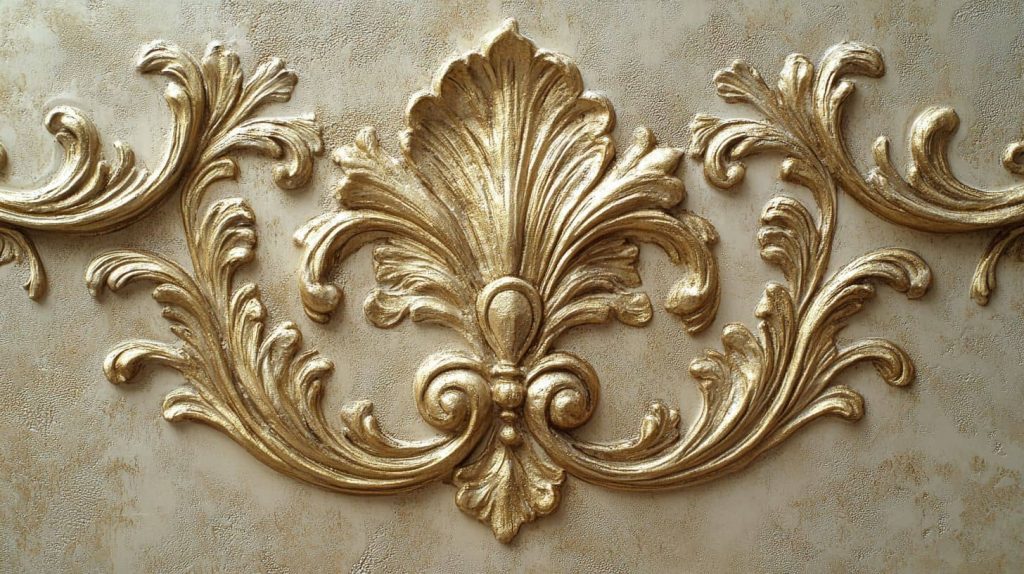
Decorative plaster brings charm and depth to any space. It creates stunning light effects and lasts for years. Plus, you can choose eco-friendly options. Want to learn more about how plaster can transform your home? Keep reading!
Adds Character and Texture
Plaster adds depth and life to your walls. It creates a rich look that plain paint can’t match. You can choose from smooth or rough textures. Each type gives your room a unique feel.
Smooth plaster looks sleek and modern. Rough plaster adds a rustic charm.
Textured plaster can hide small wall flaws too. It’s great for older homes with uneven surfaces. The depth it adds makes rooms feel cozier. Light plays off the texture in fun ways.
This can make your space more interesting day and night.
Enhances Lighting Effects
Decorative plaster can make your home shine. It reflects light in unique ways, creating a warm glow. Smooth finishes bounce light around, making rooms feel bigger and brighter. Textured plasters add depth, casting subtle shadows that create cozy spots.
This play of light and shadow brings life to your walls, turning them into works of art.
Light interacts with plaster differently throughout the day. The morning sun might highlight texture, while evening lamps can create a soft, inviting atmosphere. The right plaster finish can enhance both natural and artificial light in your space.
It’s a simple way to transform the mood of any room without changing your lights.
Durable and Long-lasting
Plaster finishes stand the test of time. They resist wear and tear better than many other wall coverings. Smooth and Venetian plasters are known for their strength. These finishes can last for decades with proper care.
They don’t chip or crack easily, even in high-traffic areas.
Plaster also ages well, gaining character over the years. It can be repaired and refreshed if needed, unlike some other materials. This makes plaster a smart choice for homeowners who want long-lasting beauty in their spaces.
The durability of plaster means less frequent replacements, saving money in the long run.
Eco-friendly Options
Plaster offers green choices for your home. Clay plaster stands out as a top eco-friendly option. It helps control moisture in rooms, making your space more comfy. Plus, it’s free of harsh chemicals and VOCs.
This means better air quality for you and your family. Other types like lime plaster also score high on the eco-scale. They absorb CO2 as they dry, which is good for the planet.
These natural plasters bring more than just green cred to your walls. They add warmth and texture too. You can pick from earthy shades that blend with any decor style. Best of all, these options last for years with little upkeep.
That means less waste and fewer resources used over time.
How to Choose the Right Plaster Finish
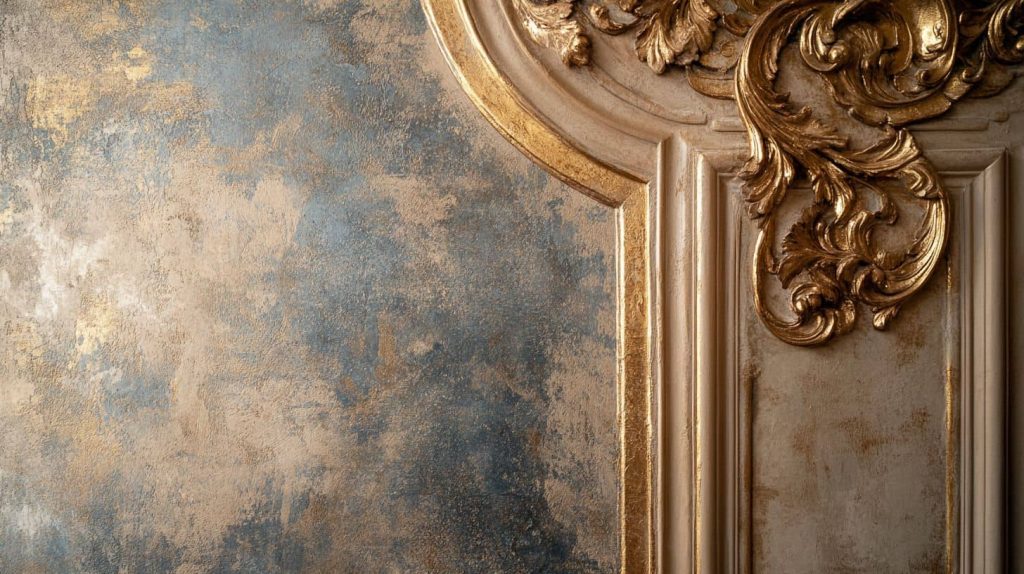
Picking the right plaster finish can make or break your interior design. Your choice affects the look, feel, and function of your space – so choose wisely!
Consider the Overall Style and Aesthetic
Look at your home’s style before picking a plaster finish. Modern homes often work well with smooth plasters. Older homes might shine with textured finishes. Think about the mood you want to create.
Smooth plasters can feel sleek and clean. Rough plasters add warmth and depth. Your choice should match the rest of your decor too.
Don’t forget about color and sheen. Some plasters come in many shades. Others take well to paint. Matte finishes suit rustic spaces. Glossy ones fit glamorous rooms. The right plaster can make your walls stand out or blend in.
It’s all about what fits your home’s look and feel.
Assess Durability and Maintenance Needs
Plaster finishes vary in how long they last and how much care they need. Some types, like smooth finishes, are easy to clean but may show wear faster. Others, such as textured finishes, hide marks better but can trap dust.
Think about how much time you want to spend on upkeep. Also, consider where you’ll use the plaster. Bathrooms and kitchens need finishes that can handle moisture and frequent cleaning.
Choose a plaster that fits your lifestyle and the room’s use. Durable options like Venetian plaster work well in high-traffic areas. They resist chips and scratches. For less-used spaces, you might pick a more delicate finish.
Ask about sealing options to protect your plaster and make it last longer. This can help cut down on future repairs and keep your walls looking fresh.
Examine Impact on Lighting and Acoustics
Plaster finishes can change how light and sound work in a room. Smooth plaster makes spaces brighter by reflecting more light. Textured plaster adds warmth and absorbs some sound, which can help quiet a noisy room.
The type of finish you pick affects the mood and feel of your space. Think about how you want the room to look and sound when choosing a plaster style.
Different plasters interact with light in unique ways. Some create soft glows, while others make sharp shadows. This can make your room feel cozy or dramatic. Plaster also impacts how sound moves.
Rough surfaces scatter sound waves, reducing echoes. Smooth ones let sound travel more freely. Pick a finish that matches your needs for both looks and comfort.
Enhancing Your Property with Professional Interior Plastering and Ceiling Restoration
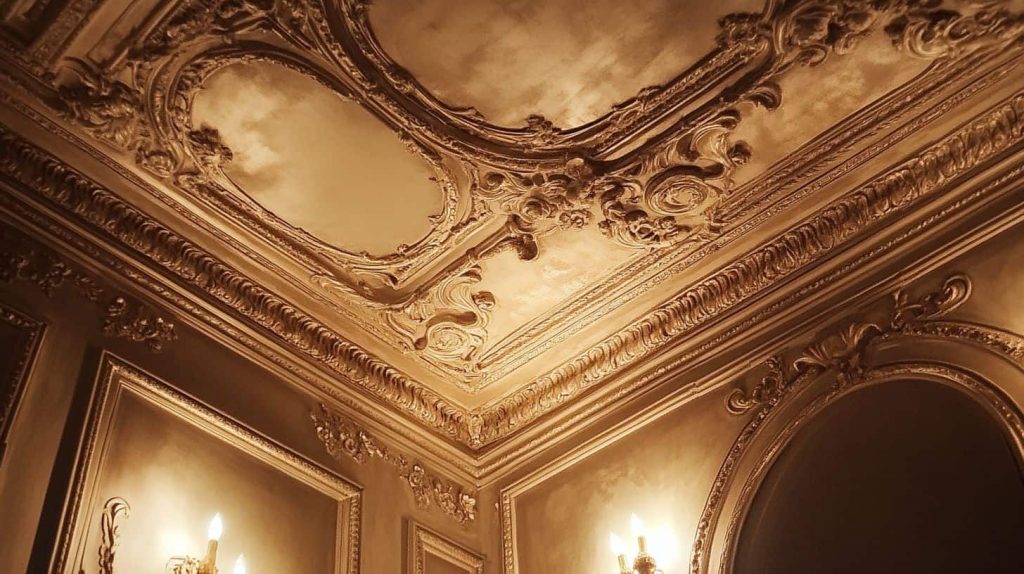
Professional plastering can boost your home’s value and charm. One Stop Plastering offers expert services to refresh your walls and ceilings. They can patch up small areas in just one day.
For bigger jobs, costs range from $10 to $25 per square foot. This price covers both labor and materials.
Plaster work adds elegance and character to any room. It’s a durable option that lasts for years. Experts can create smooth finishes or add texture for visual interest. They use special tools and methods to ensure a flawless result.
With professional help, you can turn plain walls into stunning focal points.
The Distinctive Beauty and Benefits of Venetian Plaster
Venetian plaster brings a touch of old-world charm to modern homes. This special finish looks like marble but costs less. It’s made from lime and marble dust, giving the walls a smooth, shiny look.
The plaster reflects light, making rooms brighter and more open. It’s tough too – it can last for years without cracking or peeling.
Homeowners love Venetian plaster for its beauty and practicality. It works in any room, from living areas to bathrooms. The plaster comes in many colors, so it fits any style. It’s also easy to clean and resists mold, which is great for damp spaces.
Plus, it’s eco-friendly since it’s made from natural materials. For a luxe look that lasts, Venetian plaster is hard to beat.
Common FAQs About Decorative Plastering

Decorative plastering raises many questions for homeowners. Our FAQ section tackles common queries about clay plaster, Venetian plaster, and more.
What is the advantage of using clay plaster?
Clay plaster offers many perks for homes. It’s great for people with chemical issues. The plaster doesn’t have harsh chemicals, so it’s safer to breathe. It also helps keep the air in your house fresh.
Clay plaster soaks up extra moisture when it’s damp and lets it out when it’s dry. This keeps your home comfy all year round.
Another plus is that clay plaster looks nice. You can get it in many earth tones. It adds a warm, cozy feel to any room. The plaster is tough too. It can last for years without cracking or peeling.
This means less work for you in the long run.
How is Venetian plaster applied and why is it popular?
Venetian plaster needs skill to apply. Workers put on many thin layers of plaster with special tools. They smooth and polish each layer until it shines like marble. People love Venetian plaster because it looks fancy and lasts a long time.
It can make plain walls look rich and elegant. This type of plaster is tough and can stand up to wear and tear. It’s a great choice for homes that want a touch of luxury without spending too much money.
Can decorative plaster be used in both residential and commercial spaces?
Decorative plaster works great in homes and businesses. It adds style to any space, big or small. You can use it on walls, ceilings, and even furniture. Plaster comes in many types and finishes.
This lets you match it to any look you want.
Plaster is tough and lasts a long time. It can handle wear and tear in busy places. Many shops and offices use plaster to create a classy feel. At home, it can make rooms feel cozy or grand.
From smooth to textured, plaster fits any style. It’s a smart choice for both living spaces and work areas.
Conclusion
Plaster finishes offer a world of style for your home. From smooth to textured, each type brings its own charm. Clay and lime options give eco-friendly choices. Experts can help you pick the right finish for your space.
With plaster, you can create a unique look that lasts for years to come.
FAQs
What is decorative plastering?
Decorative plastering is an art that adds character to walls and ceilings. It uses ornamental plaster to create unique textures and finishes. This method has been used throughout history to bring grandeur to spaces.
How does plaster differ from drywall?
Plaster is a versatile building material that offers more durability than drywall. It’s known for its longevity and breathability. Plaster walls can absorb and release moisture, making them great for areas prone to dampness.
What are some popular decorative plaster finishes?
Venetian plaster is a well-liked choice for its smooth, polished look. Other options include textured finishes created by special trowel techniques. Raw plaster can also be left exposed for a rustic feel.
Is plaster eco-friendly?
Yes, plaster is often free of chemicals and VOCs. It comes in a range of earthy shades and is made from natural materials. This makes it a good pick for those wanting an environmentally friendly home upgrade.
Can plaster be used in bathrooms?
Plaster can be used in bathrooms, but the type matters. Some plasters have better waterproofness than others. Gypsum plaster is less expensive and works well in most indoor spaces, including bathrooms with proper sealing.
How do I maintain plaster walls?
Plaster walls need care to stay beautiful. Regular dusting and gentle cleaning help preserve their finish. Avoid harsh chemicals. If cracks appear, fix them quickly to prevent further damage. With proper care, plaster can last for decades.



